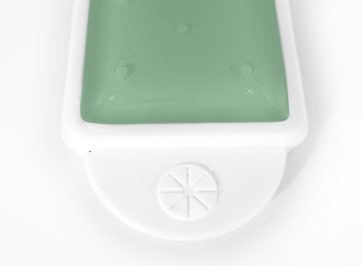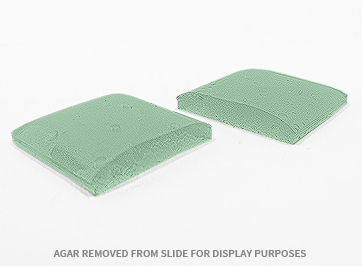Urology and Dipslides
Dipslides are a simple and effective way of testing urine for evidence of urinary tract infections. Testing methods include dipping the slide directly into a sample (for approx 10 seconds) or dropping / pouring the urine sample onto the dipslide. Samples can be taken by catheterisation or cystocentisis. With all methods, it is ideal if the dipslide is completely covered by the sample and that the excess urine is allowed to drain away before the dipslide is returned to the container. Once returned to the dipslide container, the included label can be filled in with the patient's details before it is adhered to the dipslide container. The dipslide can then be incubated at 37°C for 24 hours.
Dipslides are accompanied by a comparison chart. Using the chart, colonies are counted using colony forming units (cfu) per ml.
CLED Agar supports growth of all urinary organisms that could potentially be pathogenic. It is also fairly easy to differentiate between colonies so that diagnosing the problem accurately is more likely. For example, on CLED medium, Staphylococcus aureus grows in deep yellow colonies whereas salmonella species grow in flat blue colonies. Urinary pathogens / bacteria that grow on CLED Agar:
Escherichia coli: Opaque yellow colonies, approx 1.25mm diam. More intense colour in the centre of the colony. Non-lactose fermenting strains - blue colonies.
Klebsiella species: Colour of colonies varies from yellow to white-blue, extremely mucoid.
Proteus species: Blue colonies, translucent. Colonies often smaller than Escherichia coli.
Salmonella species: Flat colonies, blue.
Pseudomonas aeruginosa: Matte green colonies with rough periphery.
Enterococcus faecalis: Small yellow colonies (0.5mm diam.).
Staphylococcus aureus: Intense yellow colonies, 0.75mm diam.
Coagulase negative staphylococci: White or pale yellow. Colonies are more opaque than Enterococcus faecalis.
Corynebacteria: Small grey colonies.
Lactobacilli1: Small grey colonies but with rougher surface than Corynebacteria.
Vet urine culture dipslide specifications
Each dipslide features a virtually unbreakable and flexible paddle allowing for even, full surface testing.
Due to the design of the dipslide, fluids will drain off quickly during testing.
Each slide has a handle built into the lid that is recessed to help keep your fingers dry during testing.
One side of the slide will have a circle indicator so you know which side was used for testing which type of contaminant.
Each dipslide is dual sided to allow multiple contamination testing with one test.
Each agar is thick (approx 4mm) and raised above the dipslide to allow for easy surface testing.
One side of the slide is a CLED agar (green side). This will show the total viable bacterial count. If you count the number of colonies on the CLED agar and compare it with chart, it will indicate whether an infection is present based on the appropriate cfu/ml threshold. Colonies on this agar are fairly simple to differentiate. Growth characteristics can be viewed in the list of urinary pathogens in the list further up the page.
The red side (MacConkey agar) grows / tests for coliforms. Differentiates between coliforms and non lactose fermenters. Gram positive are inhibited. Salmonella and shigella species appear as straw colonies. Coliforms appear as red / pink colonies with bile precipitation.
Results and interpretation
CFU/ml values that could indicate UTI (on CLED agar)
Cystocentesis: "any level of bacterial growth may be significant, although samples from a UTI typically contain ≥103 colony forming units (CFU)/mL".2
Catheter: "≥104CFU/mL in males (dogs) and ≥105 in females (dogs)* are typically considered significant".3
"In both male and female cats, growth of more than 103 cfu/ml in samples collected by catheterisation is considered compatible with UTI".4
Voided / free catch: "greater than or equal to 105CFU/mL in dogs and 104CFU/mL in cats" 6.
Method of collection has potential for contamination of sample. Other methods are considered more accurate.
* "Values of >105 cfu/ml may result from culture of urine obtained from catheterisation in 20% of normal female dogs".5. Therefore... ''Positive cultures obtained from catheterized female dogs should be confirmed with a cystocentesis unless medically contraindicated." 7
An incubator is required to determine the results of these tests. We stock a varied range of sizes in our incubator section.The listing price is for one box of slides. Each box contains 10 slides. Minimum order is 5 boxes (50 slides).
References:
1. http://www.oxoid.com/uk/blue/prod_detail/prod_detail.asp?pr=CM0301&org=145&c=uk⟨=EN
2,3,5,7. Scott Weese, J., Blondeau, J M., Boothe, D.,Breitschwerdt, E.B., Guardabassi, L., Hillier, A.,Lloyd, D.H., Papich, M.G., Rankin, S.C., Turnidge, J.D., Sykes, J.E. (2011) Antimicrobial Use Guidelines for Treatment of Urinary Tract Disease in Dogs and Cats: Antimicrobial Guidelines Working Group of the International Society for Companion Animal Infectious Diseases, Veterinary Medicine International, p. 3
4, 6 Chew, D.J., DiBartola, S.P., Schenck, P. (2011). 2nd edn. Missouri: Elsevier Saunders, p. 48
Customer Questions
|
Q
|
Why is it important to ensure the entire paddle surface is inoculated with urine?
|
|
A
|
Whatever the sample is, it has to cover the whole of the agar or the results / count will be incorrect.
|
 MADE IN THE UK under ISO 9001
MADE IN THE UK under ISO 9001










